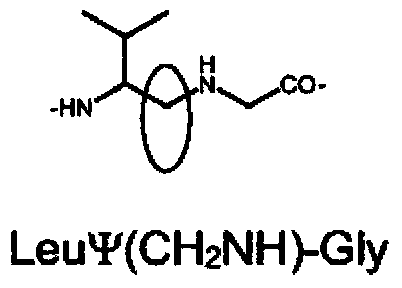Lutetium-177-labeled bombesin analogs for radiotherapy
A technology of bombesin and conjugates, applied in the field of bombesin analogs, can solve the problems of influence, cognitive function of dementia, treatment failure, etc.
- Summary
- Abstract
- Description
- Claims
- Application Information
AI Technical Summary
Problems solved by technology
Method used
Image
Examples
Embodiment 1
[0142] Example 1: Binding affinity and serum stability to GRPr
[0143] Binding affinity assay
[0144] Compound 2 was used at increasing concentrations ranging from 0.1 to 1.000 nmol / L [ 177 / nat Lu] and compound 3[ 111 / nat In], binding saturation experiments were performed. For blocking experiments, 0.8 mmol / L blocker was used. For each radioligand, triplicate samples were prepared for each concentration for both total and non-specific binding. Plates were kept on ice for 30 min before adding radioligand to the wells. After the addition of specific blockers and radioligands, plates were incubated at 4°C for 2h. After this time interval, the binding buffer was aspirated and the wells were washed twice with ice-cold phosphate-buffered saline (PBS, pH 7.4); this represents the free fraction. Cells were then harvested using 1 N NaOH; this corresponds to the bound fraction. At each radioligand concentration, specific binding was calculated by subtracting non-specific bindin...
Embodiment 2
[0150] Example 2: Biodistribution of compound 2 in PC-3 bearing mice at 1 h, 4h, 24h, 48h and 72h
[0151] Biodistribution at different time points was studied in NMRI nude mice bearing subcutaneous PC-3 tumors in the right hindlimb. Male mice weighed approximately 30 g, and 3 animals were studied per time point. After intravenous dose injection into the tail vein, mice were sacrificed at indicated time points and dissected organs were analyzed by radioactivity counts. An administered dose of 100 [mu]L per animal gave an average activity of 86 kBq.
[0152] At indicated time points, urine and feces were collected quantitatively. At the same time point, the animals were sacrificed and bled under isoflurane anesthesia, and the following organs and tissues were removed and performed using a γ-counter[ 177 Lu] Determination: spleen, liver, gallbladder, kidney, lung, femur, heart, brain, fat, thyroid, muscle, skin, blood, tail, stomach (without inclusions), prostate, intestine (...
Embodiment 3
[0166] Example 3: Radiation Dosimetry
[0167] The biodistribution data of compound 2 in PC-3 tumor bearing mice (see Example 2) were used in the radiation dosimetry calculations, estimating the mice by the MIRD (Medical Internal Radiation Dosimetry) method The organ's own dose ratio. Time activity (kinetic) data were modeled to generate residence times for compound 2.
[0168] Radiation dosimetry calculated by the Medical Internal Radiation Dose (MIRD) method shows an excellent therapeutic window (for kidney and pancreas) in mice. Considering a maximal activity of 450MBq injected per animal, a dose of 150-200Gy can be achieved in the tumor. The kidneys are not critical, instead the pancreas becomes the dose limiting organ. (In contrast to rodent pancreas, human pancreas expresses only very small amounts of GRPr).
[0169] See Figure 3.
PUM
| Property | Measurement | Unit |
|---|---|---|
| weight | aaaaa | aaaaa |
Abstract
Description
Claims
Application Information
 Login to View More
Login to View More - R&D
- Intellectual Property
- Life Sciences
- Materials
- Tech Scout
- Unparalleled Data Quality
- Higher Quality Content
- 60% Fewer Hallucinations
Browse by: Latest US Patents, China's latest patents, Technical Efficacy Thesaurus, Application Domain, Technology Topic, Popular Technical Reports.
© 2025 PatSnap. All rights reserved.Legal|Privacy policy|Modern Slavery Act Transparency Statement|Sitemap|About US| Contact US: help@patsnap.com



